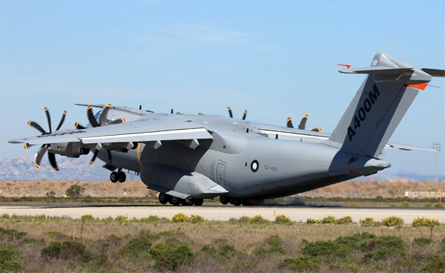Airbus Military is poised to perform its first air-drop assessments with the A400M transport, while long-running contract negotiations with its seven European customers appear to also be making significant progress.
Development aircraft MSN1, which is undergoing artificial ice trials flying from Toulouse, will soon start air-drop tests, says Fernando Alonso, Airbus Military's senior vice-president flight and integration test centre. The process will first involve releasing balls from the transport's cargo ramp and doors, before progressing to dropping instrumented dummies and then paratroops from France and the UK.
 |
|---|
© Airbus Military |
The A400M could also drop relief supplies during future humanitarian missions |
Other planned activities for the A400M for the rest of this year include braking trials at Spain's Moron air base, and completing around five outstanding flutter test flights. "We have done sufficient [tests] to be confident that our predictions are good," Alonso says, with these having already been completed at up to Mach 0.7.
Further work with a tail bumper installed will also prove the A400M's expected maximum take-off angle of around 12°, with 10° having already been demonstrated (below).
 |
|---|
© Airbus Military |
MSN1 is also to undergo receiver trials behind a Vickers VC10 tanker over a period of seven to 10 days, with the Royal Air Force type to support operations from Toulouse. To involve only dry contacts, the work will de-risk further work to be done using MSN4 next year.
Alonso says the priorities for early 2011 are to conduct natural icing trials and make the first series of landings on unprepared runways (artist's impression, below). Cold weather trials will be performed in Sweden and Canada, high-altitude operating tests made in La Paz, Bolivia, and hot weather activities conducted in Al Ain, the United Arab Emirates.
 |
|---|
© Airbus Military |
The A400M programme's current three test assets had flown a combined 200 sorties and 672 flight hours by 25 October, with Alonso revealing that the latter is around 100h fewer than planned.
One factor in this shortfall was the need to replace two Europrop International TP400-D6 engines during September: one from each of the programme's Toulouse-based aircraft. One suffered foreign object damage, while the other had an actuator failure due to pollution in its oil system. "EPI was very reactive in isolating the root cause of the problem and fixing it," Alonso says, but each change took two to three weeks to complete.
 |
|---|
© Airbus Military |
Two replacement TP400 engines had to be delivered to Toulouse from Seville |
Nonetheless, he says no major problems have been encountered to date, and Airbus expects to complete certification activities late next year.
Aircraft MSN4 is on track to make its flight debut before year-end, having recently been moved from the final assembly line at San Pablo airport near Seville to receive its hydraulics fluid and fuel. The first structure for programme's remaining development aircraft, MSN6, has also arrived at the site, with the centre wingbox to be followed within the next few weeks by its wings.
Airbus expects to sign a new production contract with Belgium, France, Germany, Luxembourg, Spain, Turkey and the UK before the end of the year. Germany is understood to have agreed to trim its purchase from 60 A400Ms to 53, which when combined with the UK's planned removal of three transports will reduce the European order to 170 aircraft.
Source: Flight International
















